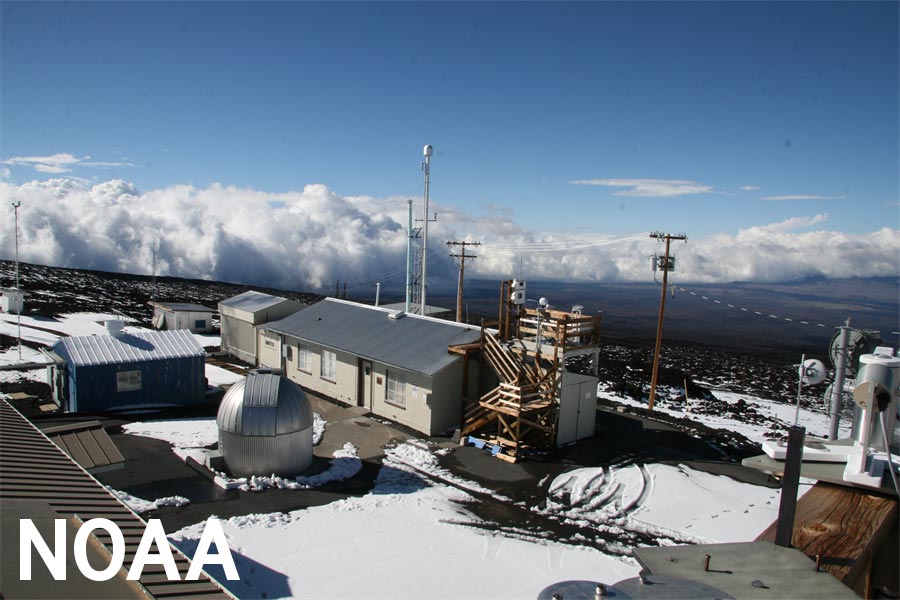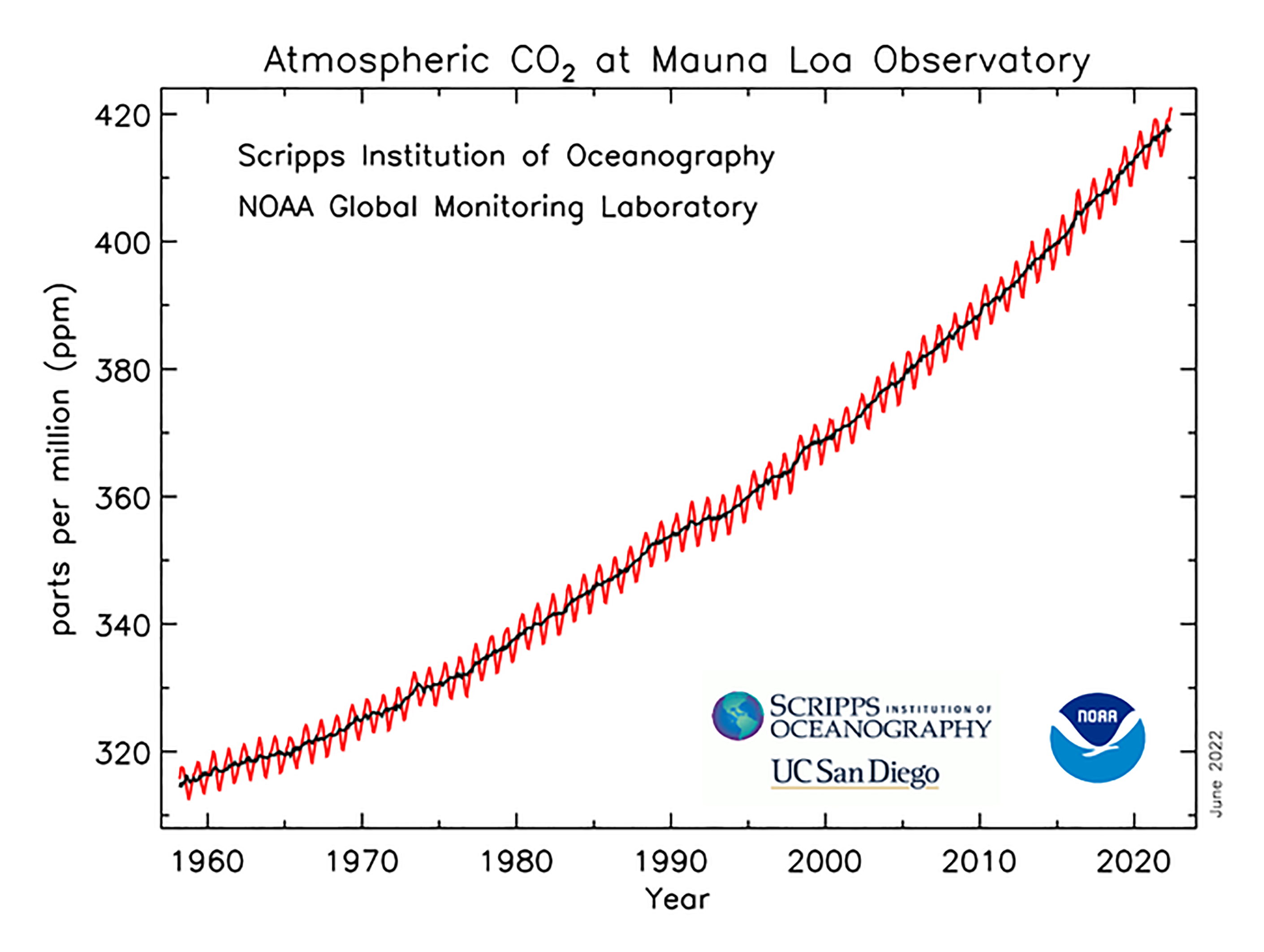
The Mauna Loa Observatory in Hawaii is a benchmark site for measuring carbon dioxide, or CO2. NOAA and the Scripps Institution of Oceanography make independent measurements from this station on the slopes of Mauna Loa volcano. (NOAA)
June 5, 2022 - Carbon dioxide measured at NOAA’s Mauna Loa Atmospheric Baseline Observatory peaked for 2022 at 421 parts per million in May, pushing the atmosphere further into territory not seen for millions of years, scientists from NOAA and Scripps Institution of Oceanographyoffsite link at the University of California San Diego announced last week.
NOAA's measurements of carbon dioxide at the mountaintop observatory on Hawaii’s Big Island averaged 420.99 parts per million (ppm), an increase of 1.8 ppm over 2021. Scientists at Scripps, which maintains an independent record, calculated a monthly average of 420.78 ppm.
“The science is irrefutable: humans are altering our climate in ways that our economy and our infrastructure must adapt to,” said NOAA Administrator Rick Spinrad, Ph.D. “We can see the impacts of climate change around us every day. The relentless increase of carbon dioxide measured at Mauna Loa is a stark reminder that we need to take urgent, serious steps to become a more Climate Ready Nation.”
CO2 pollution is generated by burning fossil fuels for transportation and electrical generation, by cement manufacturing, deforestation, agriculture and many other practices. Along with other greenhouse gases, CO2 traps heat radiating from the planet’s surface that would otherwise escape into space, causing the planet’s atmosphere to warm steadily, which unleashes a cascade of weather impacts, including episodes of extreme heat, drought and wildfire activity, as well as heavier precipitation, flooding and tropical storm activity.
Impacts to the world's oceans from greenhouse gas pollution include increasing sea surface temperatures, rising sea levels, and an increased absorption of carbon, which makes sea water more acidic, leads to ocean deoxygenation, and makes it more difficult for some marine organisms to survive.
Prior to the Industrial Revolution, CO2 levels were consistently around 280 ppm for almost 6,000 years of human civilization. Since then, humans have generated an estimated 1.5 trillion tons of CO2 pollutionoffsite link, much of which will continue to warm the atmosphere for thousands of years.
CO2 levels are now comparable to the Pliocene Climatic Optimum, between 4.1 and 4.5 million years ago, when they were close to, or above 400 ppm. During that time, sea levels were between 5 and 25 meters higher than todayoffsite link, high enough to drown many of the world’s largest modern cities. Temperatures then averaged 7 degrees Fahrenheit higher than in pre-industrial times, and studies indicateoffsite link that large forests occupied today’s Arctic tundra.

Mauna Loa ideally located to monitor global pollution
NOAA’s observatory, situated high on the slopes of the Mauna Loa volcano, is the global benchmark location for monitoring atmospheric CO2. At an elevation of 11,141 feet above sea level, the observatory samples air undisturbed by the influence of local pollution or vegetation, and produces measurements that represent the average state of the atmosphere in the northern hemisphere.
Charles David Keeling, a scientist with the Scripps Institution of Oceanography, initiated on-site measurements of CO2 at NOAA’s weather station on Mauna Loa in 1958. Keeling was the first to recognize that CO2 levels in the Northern Hemisphere fell during the growing season, and rose as plants died back in the fall, and he documented these CO2 fluctuations in a record that came to be known as the Keeling Curveoffsite link. He was also the first to recognize that, despite the seasonal fluctuation, CO2 levels were rising every year.
NOAA began measurements in 1974, and the two research institutions have made complementary, independent observations ever since. Keeling’s son, geochemist Ralph Keeling, runs the Scripps program at Mauna Loa.
“It's depressing that we've lacked the collective will power to slow the relentless rise in CO2,” said Keeling. “Fossil-fuel use may no longer be accelerating, but we are still racing at top speed towards a global catastrophe.”
The Mauna Loa data, together with measurements from sampling stations around the world, are incorporated by NOAA’s Global Monitoring Laboratory into the Global Greenhouse Gas Reference Network, a foundational research dataset for international climate scientists and a benchmark for policymakers attempting to address the causes and impacts of climate change.
Despite decades of negotiation, the global community has been unable to significantly slow, let alone reverse, annual increases in atmospheric CO2 levels.
“Carbon dioxide is at levels our species has never experienced before — this is not new,” said Pieter Tans, senior scientist with the Global Monitoring Laboratory. “We have known about this for half a century, and have failed to do anything meaningful about it. What's it going to take for us to wake up?"
To visualize how sea level rise may affect your community, visit NOAA’s sea level rise viewer, at: https://coast.noaa.gov/slr/
Source: NOAA

